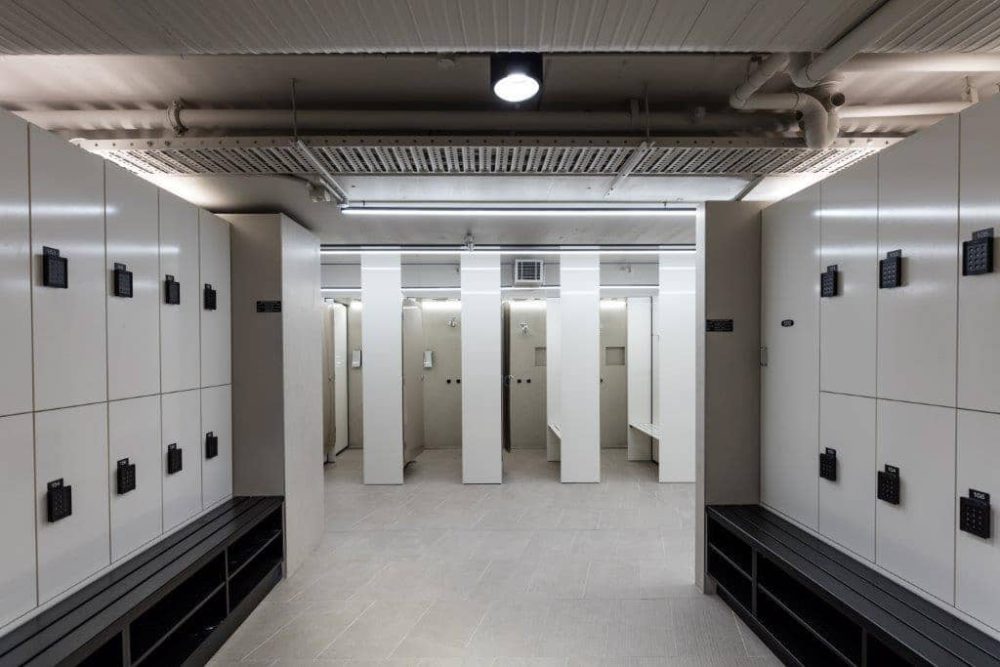End of trip facilities are becoming increasingly common in Australian commercial buildings, with some states and territories going as far as legally mandating them. We find out what they are, who needs them and the best way to manage them.
What are end of trip facilities?
End of trip facilities (or EOTs) include changing rooms, showers, lockers and secure bicycle storage areas in a commercial building’s common area. They are designed to support people who cycle, walk or run to work or exercise during their lunch break. They’re also increasingly used by employees to freshen up after returning from a business trip or get ready for an evening function.
The benefits of end of trip facilities
Providing quality EOTs benefits individuals, businesses, building owners and the environment.
Because EOTs make it easier for people to exercise and engage in physical activity, they promote higher levels of health and wellbeing among workforces. This can, in turn, result in greater productivity and increased staff morale and retention.
Well-equipped, clean EOTs encourage people to use non-motorised transport to get to work, which is great for the environment, as well as fostering a positive corporate image. They can also increase a building’s Green Star rating and make it more attractive to prospective tenants.
What building owners need to know about end of trip facilities
Well-appointed EOTs are no longer an optional ‘nice to have’ feature in a commercial building. In competitive capital city property markets, they’re a must-have, and in some Australian states and territories, they’re now a legal requirement.
High-end buildings in the Sydney CBD have been focusing on luxe EOTs for several years now as building owners recognise the demand from corporate and government tenants. A 2015 report from Colliers International revealed the desire for EOTs was one of the major drivers of demand in Australian CBD property markets, and that appetite has only increased in recent years thanks, in part, to a COVID-inspired cycling boom.
Data from 2021 shows that cycling more than doubled across inner-city Sydney in the two years prior, and in April this year, the City of Sydney announced plans for a 250km network of strategic cycle paths across eastern Sydney. As more and more Sydney commuters choose to get to work by bike, the demand from commercial tenants for EOTs will only grow.
Meanwhile, in the ACT, recently passed legislation requires new buildings and those undergoing significant refurbishments to include EOTs by law. The new code, set to be introduced later this year, will see new commercial buildings, including takeaway food shops, funeral parlours, cinemas, and offices, required to provide EOTs. Existing buildings undergoing work affecting more than half their floor area will also be subject to the new code.
It’s a similar situation in Queensland, where the sustainable buildings development code requires all new major developments, as well as large-scale additions to existing significant buildings, to include EOTs. New developments with a floor area greater than 2,000 square metres, such as shopping centres, tertiary education facilities, commercial office buildings and hospitals, are affected. Refurbishments of existing major buildings that add 1,000 square metres or more of new floor space to the building must also provide EOTs.
How to make end of trip facility management easy with DIVVY technology
Of course, with the provision of EOTs comes the responsibility of managing them. A first-in, best-dressed approach is destined to fail – people need to know there will be a bike parking space and locker awaiting them when they arrive at the office, and they need to know their possessions are secure while they’re working.
The easiest and simplest way to manage EOTs is via a flexible booking system designed specially to manage shared assets, like DIVVY’s bookable assets system. DIVVY has taken its years of experience designing, installing and managing efficient and effective parking technology and access control systems and applied it to all bookable assets, including EOTs, meeting rooms, hot desks and shared workspaces.
Employees simply log onto the DIVVY portal and book their EOTs within the parameters set by the business. They then receive a QR code on their phone, which gives them access to the facilities they have booked. It’s that simple.
The DIVVY bookable assets system gives employees peace of mind, knowing their EOTs are booked and waiting for them when they get to work. They also know their belongings are secure because the only way the DIVVY booking system will release them is with their unique QR code.
And, of course, DIVVY’s booking system takes the burden of manual EOT management away from building management, admin and security teams. No more spreadsheets, granting and revoking access permissions from security cards, or dealing with frustrated staff who can’t access the facilities they need.
The same DIVVY booking system can be applied to office access, streamlining the process of access control, and reserving meeting rooms, turning an arduous process into an easy one and ensuring meeting rooms are used as efficiently as possible.
When applied across EOTs, office access, meeting rooms, and car parking, DIVVY technology creates a seamless, easy-to-use network across a business’s entire bookable assets portfolio.
To find out how DIVVY can make your business’s bookable assets work harder for you, get in touch with our sales team today.
